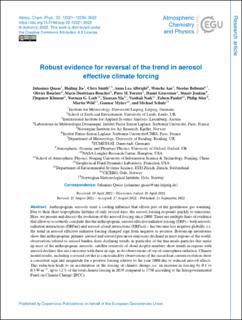| dc.contributor.author | Quaas, Johannes | |
| dc.contributor.author | Jia, Hailing | |
| dc.contributor.author | Smith, Chris | |
| dc.contributor.author | Albright, Anna Lea | |
| dc.contributor.author | Aas, Wenche | |
| dc.contributor.author | Bellouin, Nicolas | |
| dc.contributor.author | Boucher, Olivier | |
| dc.contributor.author | Doutriaux-Boucher, Marie | |
| dc.contributor.author | Forster, Piers M. | |
| dc.contributor.author | Grosvenor, Daniel | |
| dc.contributor.author | Jenkins, Stuart | |
| dc.contributor.author | Klimont, Zbigniew | |
| dc.contributor.author | Loeb, Norman G. | |
| dc.contributor.author | Ma, Xiaoyan | |
| dc.contributor.author | Naik, Vaishali | |
| dc.contributor.author | Paulot, Fabien | |
| dc.contributor.author | Stier, Philip | |
| dc.contributor.author | Wild, Martin | |
| dc.contributor.author | Myhre, Gunnar | |
| dc.contributor.author | Schulz, Michael | |
| dc.date.accessioned | 2022-09-27T06:50:04Z | |
| dc.date.available | 2022-09-27T06:50:04Z | |
| dc.date.created | 2022-09-21T12:28:34Z | |
| dc.date.issued | 2022 | |
| dc.identifier.citation | Atmospheric Chemistry and Physics (ACP). 2022, 22, 12221-12239. | en_US |
| dc.identifier.issn | 1680-7316 | |
| dc.identifier.uri | https://hdl.handle.net/11250/3021582 | |
| dc.description.abstract | Anthropogenic aerosols exert a cooling influence that offsets part of the greenhouse gas warming. Due to their short tropospheric lifetime of only several days, the aerosol forcing responds quickly to emissions. Here, we present and discuss the evolution of the aerosol forcing since 2000. There are multiple lines of evidence that allow us to robustly conclude that the anthropogenic aerosol effective radiative forcing (ERF) – both aerosol–radiation interactions (ERFari) and aerosol–cloud interactions (ERFaci) – has become less negative globally, i.e. the trend in aerosol effective radiative forcing changed sign from negative to positive. Bottom-up inventories show that anthropogenic primary aerosol and aerosol precursor emissions declined in most regions of the world; observations related to aerosol burden show declining trends, in particular of the fine-mode particles that make up most of the anthropogenic aerosols; satellite retrievals of cloud droplet numbers show trends in regions with aerosol declines that are consistent with these in sign, as do observations of top-of-atmosphere radiation. Climate model results, including a revised set that is constrained by observations of the ocean heat content evolution show a consistent sign and magnitude for a positive forcing relative to the year 2000 due to reduced aerosol effects. This reduction leads to an acceleration of the forcing of climate change, i.e. an increase in forcing by 0.1 to 0.3 W m−2, up to 12 % of the total climate forcing in 2019 compared to 1750 according to the Intergovernmental Panel on Climate Change (IPCC). | en_US |
| dc.language.iso | eng | en_US |
| dc.rights | Navngivelse 4.0 Internasjonal | * |
| dc.rights.uri | http://creativecommons.org/licenses/by/4.0/deed.no | * |
| dc.title | Robust evidence for reversal of the trend in aerosol effective climate forcing | en_US |
| dc.type | Peer reviewed | en_US |
| dc.type | Journal article | en_US |
| dc.description.version | publishedVersion | en_US |
| dc.rights.holder | © Author(s) 2022. | en_US |
| dc.source.pagenumber | 12221-12239 | en_US |
| dc.source.volume | 22 | en_US |
| dc.source.journal | Atmospheric Chemistry and Physics (ACP) | en_US |
| dc.identifier.doi | 10.5194/acp-22-12221-2022 | |
| dc.identifier.cristin | 2053879 | |
| dc.relation.project | EC/H2020/821205 | en_US |
| dc.relation.project | EC/H2020/820829 | en_US |
| dc.relation.project | EC/H2020/724602 | en_US |
| cristin.ispublished | true | |
| cristin.fulltext | original | |
| cristin.qualitycode | 2 | |

